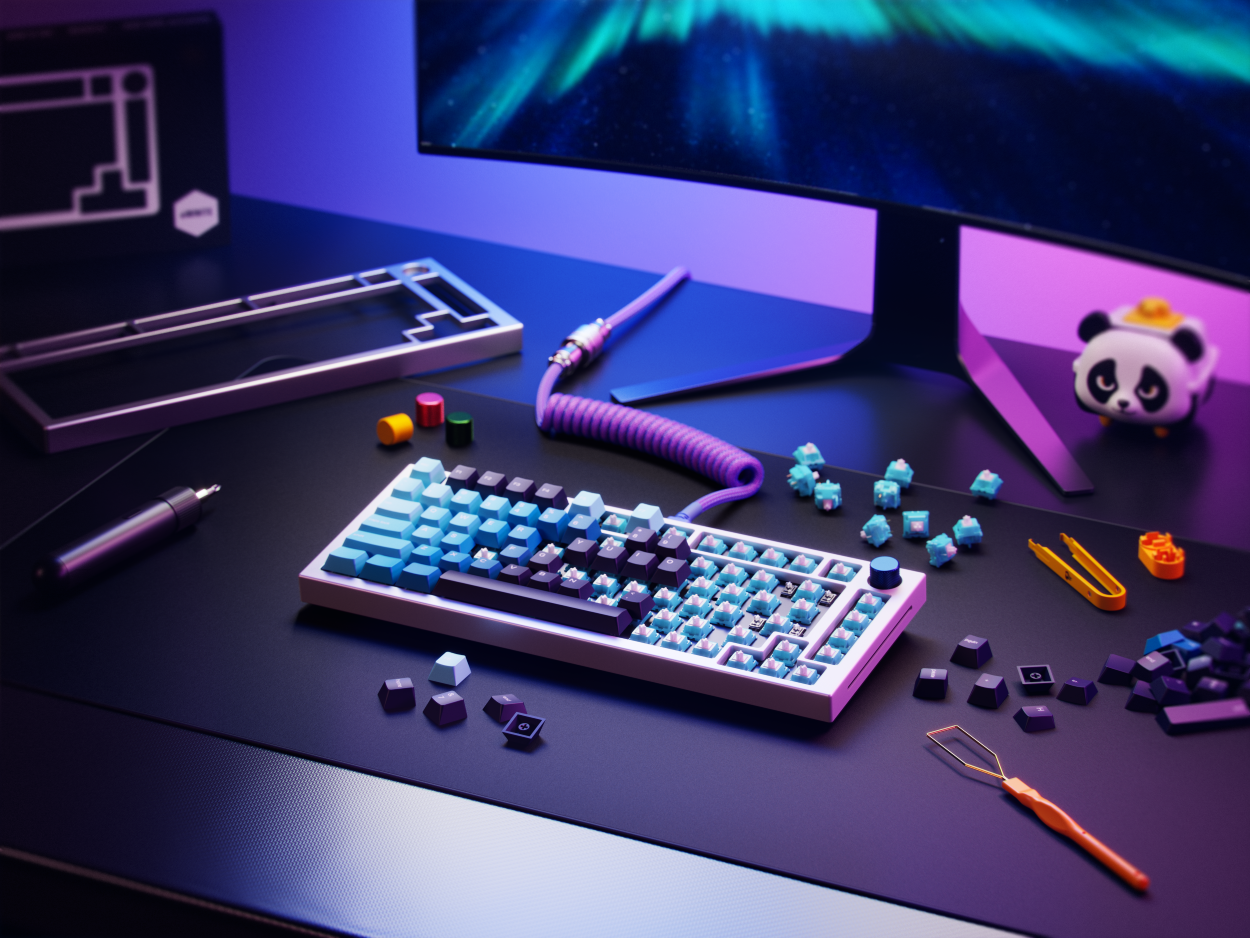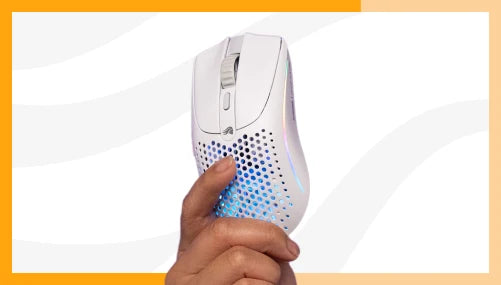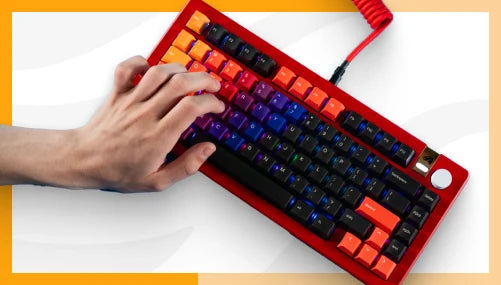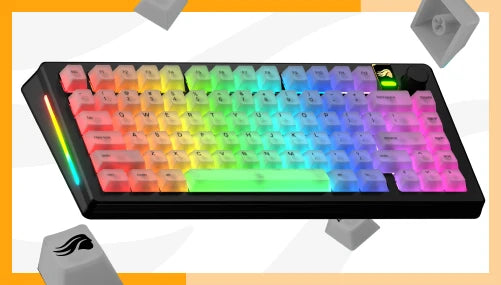
Keyboard ASMR: 5 Ways to Modify and Improve Acoustics
Resources
May 25 2023
Keyboards are more than just tools for typing; they have become a form of self-expression and a hobby for many. One aspect that enthusiasts often focus on is modifying the sound, which can greatly affect the typing experience, providing a satisfying auditory feedback that enhances the overall enjoyment.
In this blog post, we will explore why people enjoy modifying their keyboards, and provide you with a step-by-step guide to modify your own keyboard. We’ll also showcase five different GMMK PRO configurations, each offering a unique sound experience.

Why Modify Your Keyboard?
1) Personalization: Modifying the sound of your keyboard allows you to tailor it to your preferences and create a unique experience. Whether you prefer a deep thock, a crisp click, or a smooth whisper, customization options are endless.
2) Aesthetics: Beyond the sound, modifications often involve changing keycaps, adding dampening materials, or even altering the case. These modifications can transform your keyboard into a visually appealing and personalized work of art.
3) Tactile Satisfaction: The tactile feedback of a keyboard can significantly impact the typing experience. By modifying the switches, stabilizers, and plates, you can achieve the desired level of tactile response, resulting in a more satisfying keystroke.

How to Modify Your Keyboard
1) Choose Your Keyboard: Select a mechanical keyboard that allows for easy customization, such as the GMMK PRO, which offers an extensive range of switch options, top plates, stabilizers, plate materials, keycaps, and much more.
2) Choose Your Configuration: This step is a bit tricky, since the best way to find the perfect configuration for you is by experimenting. We recommend trying out different modding tools like switch lubricants, films, stabilizer grease, foam, gaskets, and more.
3) Disassemble Your Keyboard: Carefully disassemble your keyboard, taking note of the specific components and their placement. Slow and steady wins the race!
4) Switch Modification: A great place to find your ideal configuration is by experimenting with switches. From trying out a switch sample pack, applying lubricant, adding switch films for reducing wobble, the more variations you try, the better you’ll discover your preference.
5) Stabilizer Modification: Lubricate the stabilizers to reduce noise and improve the typing feel. Or swap them out all together with premium-grade stabs like the GSV2.
6) Case Modifications: Explore options such as adding dampening foam or gaskets between the plate and case to reduce vibrations and enhance sound characteristics. The FlexKit is excellent for keyboard sound modification since it comes with a wide range of bottom cases, gaskets, and much more. For just $60, it’s an unbeatable deal.
Learn more about the FlexKit and how it enhances your board’s flexibility and acoustics.-
7) Keycap Customization: Complete your modification journey by selecting keycaps that match your desired aesthetic and typing experience.

Keyboard ASMR: GMMK PRO Keyboard Sound Test
Now, let's delve into the sound tests in the videos for some keyboard asmr goodness:
Video 1: Live GMMK PRO Sound Test by Alexotos | Linear Switches w/ PC Plate
In this video, Alexotos showcases the GMMK PRO White Ice with a polycarbonate plate. The keyboard features Banana Split switches that are lubricated and filmed, along with Durock V1 stabilizers lubricated with dielectric grease and 205g0. The resulting sound offers a smooth and refined typing experience.
Video 2: Live GMMK PRO Sound Test by Alexotos | Tactile Switches w/ Aluminum Plate
Here, Alexotos presents the GMMK PRO Black Slate with an aluminum plate. The keyboard incorporates SP-Star switches lubricated with 3204, and Durock V1 stabilizers lubricated with dielectric grease and 205g0. This configuration produces a tactile typing experience with a satisfying feedback.
Video 3: GMMK PRO Sound Test | Linears on Deskmat
This video highlights two different configurations of the GMMK PRO. The first configuration features Gateron Blacks with stock stabilizers, while the second configuration includes Gateron Blacks lubricated and filmed switches, re-lubricated stabilizers, and other modifications such as band-aid mods and spacebar foam. The comparison demonstrates the impact of simple mods on the sound and feel of the keyboard.
Video 4: GMMK PRO Sound Test | SP-Stars w/ Aluminum Plate
The GMMK PRO with an aluminum plate and SP-Star switches (lubricated with 3204 and oiled springs) is showcased in this video. Durock V1 stabilizers lubricated with dielectric grease and 205g0 enhance the stability and sound. The ePBT Kuro Shiro keycaps and GMK Spacebar complete the aesthetic.
Video 5: GMMK Pro Sound Test | Banana Split Switches w/ PC Plate
In this video, the GMMK PRO White Ice is presented with the Glorious polycarbonate plate. The keyboard features Banana Split switches, Durock V1 stabilizers lubricated with dielectric grease and 205g0, and GMK Voyager keycaps. The additional layer of gaskets on the top plate enhances the sound profile.
Bottom Line
Modifying the sound of your keyboard opens up a world of customization and personalization. Whether you prefer linear, tactile, or clicky switches, the process of modification allows you to achieve the perfect sound and typing experience tailored to your liking. The showcased videos provide a glimpse into the possibilities and inspire you to embark on your own keyboard modification journey. Remember, with the right tools, materials, and patience, you can transform your keyboard into a delightful auditory and visual experience.
Frequentlty Asked Questions
1. How can I modify my keyboard?
Modifying or modding a keyboard involves a range of steps tailored to meet your individual needs. Here's a simplified guide to keyboard modding:
1) Identify the Purpose: Your modification goals could range from enhancing typing comfort, improving keyboard aesthetics, to refining the sound of keystrokes.
2) Choose the Right Mechanical Keyboard: This largely depends on your goals. First, make sure the keyboard is hotswappable for easy customization. You can choose a Prebuilt, which is ready to use out of the box, and can be modified later. Or a Barebones board, so you can choose the components. Items like FlexKit Bundle allow you to build a GMMK PRO to your exact specifications from the ground up.
3) Gather Tools and Materials: For most modifications, you'll need a keycap puller, switch puller, lube (like Krytox GPL 205 or our G-Lube), O-rings, and stabilizers.
4) Modifying Process: The procedure varies from lubing the switches and stabilizers (or switching them out for more premium-grade ones), adding O-rings to dampen sound, swapping keycaps, switch plates, or keyboard cases.
5) Finalize: After modifying, test the keyboard for any errors and make necessary adjustments.
Remember, each keyboard and modding process is unique. Experience may differ, but the main idea is that you enjoy the process.
2. What does modding a keyboard do?
Modding a keyboard allows users to personalize and optimize their keyboards to their specific preferences. Key benefits of keyboard modding include:
Enhanced Typing Experience: Modding can improve the overall feel of the keyboard, making typing more enjoyable and comfortable. This could involve changing the switches, keycaps, or adding padding for wrist support.
Sound Optimization: Sound dampening mods such as lubing switches or adding O-rings can reduce noise, producing a more pleasing and less distracting sound when typing.
Aesthetics: Keycap changes, case swaps, and LED modifications can make your keyboard visually appealing.
Performance: Certain mods like altering switch types can tailor your keyboard's performance to specific tasks, such as gaming or coding.
3. Is keyboard modding hard?
Keyboard modding is not necessarily hard, but it does require patience, time, and a willingness to learn. The complexity of the modification depends on the modding process. Simple mods like swapping keycaps or adding O-rings can be straightforward and beginner-friendly. However, more advanced mods like soldering new switches, lubing, or building a custom keyboard can be challenging and might require technical skills. For this very reason, keyboards like the original GMMK, the GMMK 2, and the GMMK PRO are excellent options for modification since they do not require soldering.
4. How can I make my keyboard sound better?
Improving your keyboard's sound can be achieved in several ways:
Lubricating Switches and Stabilizers: Lubricating these components can reduce friction and, in turn, the noise produced during typing.
Adding O-rings: O-rings can be added beneath the keycaps to dampen the sound produced by the keys' bottoming out.
Using Sound Dampening Materials: Materials like foam or silicone can be added inside the keyboard case to absorb the sound produced while typing.
Changing Keycaps: Keycaps made from different materials produce different sounds. PBT keycaps, for example, often result in a lower pitched and fuller sound than ABS keycaps.
Remember, what sounds better is often subjective, so try out different mods to find the one that suits your preference.


